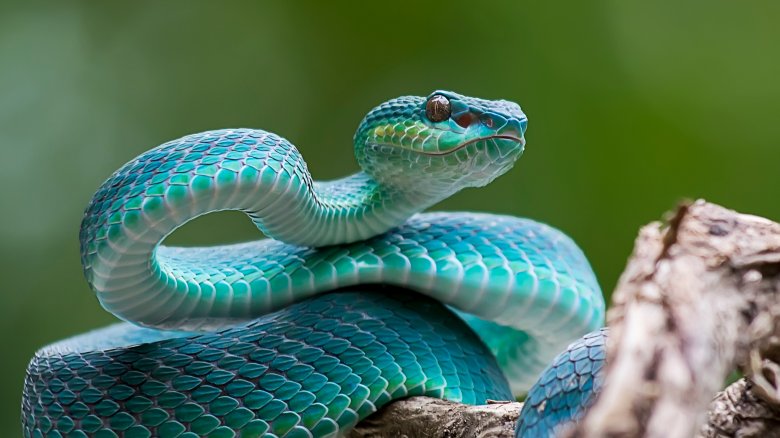The Truth About Why There Aren't Snakes In Ireland
Everyone's heard the basic story: There are no snakes in Ireland because St. Patrick drove them away. While that's not entirely true, both the full legend and the science behind Ireland's distinct lack of snakes is fascinating stuff.
Medieval legend and lore says it wasn't just snakes that St. Patrick drove from the Emerald Isle. According to a medieval Scottish monk named Jocelyn (via the Irish Times), "Ireland since its first habitation had been pestered with a triple plague, namely, a great abundance of venomous reptiles, with myriads of demons visibly appearing with a multitude of magicians."
The demons had a leader named Crum Dubh, who lived on Cruach Phadraig (a mountain in what's now County Mayo). After praying — a lot — St. Patrick went head-to-head with the demon and cast him, his minions, his snakes, and his magicians out of the land. The snakes were supposedly hurled into Log na nDeamhan, a lake at the base of the mountain, and all was well and good in the world.
St. Patrick was a very real person, and it's important to point out that, according to Nigel Monaghan, keeper of the Natural History Museum, that he never actually claimed to be the one responsible for Ireland's snake-free landscape. The traditional date of St. Patrick's arrival in Ireland is 432 (via Library Ireland), and the stories didn't start circulating until centuries later.
That's extra strange because scholars had been writing about Ireland's lack of snakes since at least the third century, and Monaghan says that after looking through thousands of years of Irish fossil records, he found there were never any snakes in Ireland to begin with. There was "nothing for St. Patrick to banish."
National Geographic says the real reason snakes never colonized Ireland goes back to the last ice age. The entire country would have been way too cold for reptiles, and when the climate started to warm, Ireland was cut off from everything around it by rising sea levels and melting glaciers. Snakes — who are slow to spread to new areas — simply never made it to Ireland before it became an island but did make it to Britain. They were connected to mainland Europe for about 2,000 years longer than Ireland, and have three native snake species.
As a strange footnote to the story, there's only one reptile native to Ireland: the viviparous lizard. (It was only in the 1970s that the Irish Times reports a type of legless lizard was discovered flourishing in the Burren, likely a newcomer.)
So, if there were never any snakes in Ireland to begin with and ancient writers and historians knew that, why does everyone think there was this snake plague?
One theory is that since snakes were often symbols of evil in Judeo-Christian tales, they simply represented something else. Patheos says it's sometimes claimed the "snakes" were early pagans, and St. Patrick drove them out of the country and converted others to Christianity. But some historians have offered pretty powerful arguments about why that just couldn't be true: Ireland's conversion from pagan worship to Christianity had already begun before St. Patrick arrived, and it continued for centuries after he left. Some scholars even date the "final" push of Christianity into Ireland to the 14th century.
Another possible inspiration for the story could be found in a recent translation of a sixth-century text (via the Independent), which tells of a cult who worshiped the Crom Cruich. They were equal parts powerful and bloodthirsty, and they practiced a terrifying bit of human sacrifice. According to the texts, every year on Samhain it was expected that a first-born child would be sacrificed to guarantee a good harvest.
According to the text, the cult and the annual sacrifice ended when St. Patrick and his followers stormed their sites, destroyed their idols, and blessed the area. No retribution from an angry pagan god ever came, and the cult faded into obscurity. The symbol of the cult was a snake, so it's entirely possible that the destruction of the Crom Cruich was the source of the legend, and those were the snakes St. Patrick drove away.
It's also worth noting that there are — technically — snakes in 21st-century Ireland. During the economic boom period called the Celtic Tiger (mid-1990s to late 2000s), countless people started keeping snakes as pets. The New York Times says that thanks to their association with St. Patrick and their rarity, they became a status symbol. When the economic prosperity came crashing down, many could no longer afford to keep them and released their snakes into the wild. There were so many that sanctuaries have been set up to care for them, leading many to ask why it's perfect legal to buy, import, and own snakes — even venomous ones — in a country that has almost no stocks of antivenim. Somebody call St. Patrick back!
